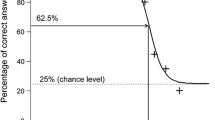Abstract
Two visual field indices, the mean defect (MD) of Flammer and the mean deviation (MD) of Heijl, have found wide acceptance among perimetrists. We compared these indices in 169 visual fields from normal- and high-tension glaucomatous eyes. Visual field damage in these eyes varied from slight to severe. In computations of the mean deviation index, the threshold values are weighted by the threshold deviations obtained from normal eyes as a function of eccentricity. However, the present study shows that the differences between the two indices in the population studied are negligible. Thus, subsequent interpretation is not affected by the choice of index, and the two MD indices may be considered to be interchangeable for the types of visual fields used in this study and for program-G1 examinations carried out using Octopus automated perimeters. Since we found smaller increases in local intersubjective fluctuations as a function of eccentricity in 274 normal visual fields as compared with results published by others, caution is indicated for interpretation of the visual field using probability weighting.
Similar content being viewed by others
References
Anonymous (1986) STATPAC: user's guide. Allergan-Humphrey, San Leandro, California
Fankhauser F (1979) Problems related to the design of automated perimeters. Doc Ophthalmol 47:89–138
Fankhauser F, Bebie H, Flammer J (1988) Threshold fluctuations in the Humphrey Field Analyzer and in the Octopus Automated Perimeter. Invest Ophthalmol Vis Sci 29:1466
Flammer J (1986) The concept of visual field indices. Graefe's Arch Clin Exp Ophthalmol 224:389–392
Flammer J, Drance SM, Augustiny L, Funkhouser A (1985) Quantification of glaucomatous visual field defects with automated perimetry. Invest Ophthalmol Vis Sci 26:176–181
Flammer J, Jenni A, Keller B, Bebie H (1987) The Octopus glaucoma program G1. Glaucoma 9:67–72
Funkhouser A, Fankhauser F (1990) A comparison of the mean defect and mean deviation indices. Jpn J Ophthalmol 34:414–420
Heijl A (1987) The implications of the results of computerized perimetry in normals for the statistical evaluation of glaucomatous visual fields. In: Kriegelstein GK (ed) Glaucoma update III. Springer, Berlin Heidelberg New York, pp 115–122
Heijl A, Asman P (1989) A clinical study of perimetric probability maps. Arch Ophthalmol 107:199–203
Heijl A, Lingren G, Olsson J (1987) Normal variability of static perimetry threshold values across the central visual field. Arch Ophthalmol 105:1544–1549
Heijl A, Lingren G, Olsson J (1987) A package for the statistical analysis of visual fields. Doc Ophthalmol Proc Ser 49:153–168
Heijl A, Lingren O, Olsson J (1988) Visual field interpretation with empiric probability maps. Arch Ophthalmol 107:204–208
Katz J, Sommer A (1988) Reliability indices of automated perimetric tests. Arch Ophthalmol 106:1252–1254
Krakau CET (1979) Temporal summation and perimetry. Ophthalmol Res 21:49–55
Olsson J, Lingren G, Heijl A (1987) Methods used to analyze the variability of visual field increment thresholds in the central visual field. Statistical research report. University of Lund, Lund, Sweden
Author information
Authors and Affiliations
Additional information
The authors have no proprietary interests in the equipment or companies referred to in this paper
Offprint requests to: A.T. Funkhouser
Rights and permissions
About this article
Cite this article
Funkhouser, A., Fankhauser, F. The effects of weighting the “mean defect” visual field index according to threshold variability in the central and midperipheral visual field. Graefe's Arch Clin Exp Ophthalmol 229, 228–231 (1991). https://doi.org/10.1007/BF00167873
Received:
Accepted:
Issue Date:
DOI: https://doi.org/10.1007/BF00167873




